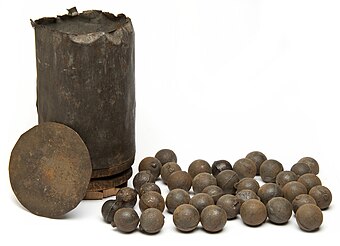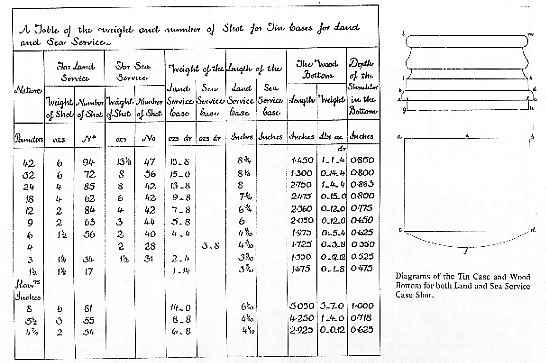Of the many forms of artillery ammunition in general
used during the 18th century, case shot was second only to the round shot.
In land
service in the field, it was by far the most used. This was particularly true in areas
such as North America, where there were bad roads where roads existed, and worse tracks
where they did not, and where the light brass gun reigned supreme. Case shot was used
almost exclusively in wars in which both cavalry and infantry relied heavily on artillery
support.
Less generally appreciated is the fact that case-shot was also used
at sea where the authorized loadings were generally heavier than with the land service
pattern.
Such a
generally used form of ammunition, which was frequently of decisive importance in the
comparatively formal battles and in skirmishes and ambushes,seem worthy of particular
study. The object of this article is to establish what case shot was, which guns used it,
how it was used, and what effect it had in tactical situations.
In the
eighteenth century, grape shot was a general term embracing all forms of artillery
ammunition made up of small shot.
Tin case shot was originally classified as a
variety of grape shot. The same period (about 1745) saw the formal introduction of light
field artillery as a class. One reference notes that tin case shot was recommended for
field service on the grounds that it was more compact and less expensive, and the
inference is that before this date, some other form of grape shot had been in use. The
same manuscript refers to matted grape and cluilted grape, and makes it clear that the
nine shot quilted grape which is comparatively well known was specifically for sea
service.
In April 1755, probably as a part of the general re-organization
of artillery which took place then, there was a regulation promulgated concerning Tin Case
Grape Shot for Land Service.
The record is fragmentary, but where it overlaps the
1745 recommendation it is apparent that there was some difference. Nevertheless, the value
of the 1755 regulation is that it makes it perfectly clear that Tin Case Shot did not
change during its life as all the components are listed: the shot, tin case, wooden
bottom, flannel cartridge, and the parchment cap and wrapping.
The only variation
was that the parchment was replaced by cartridge paper.

12-Pounder Case Shot. (Minnesota Historical Society)
Although Tin Case Shot is generally well known to historians, it is not universally
appreciated how it was made.
Tin case shot consisted of a number of iron shot placed
in a cylindrical box called a canister, which just fitted the bore of the gun or howitzer.
The canister was made of iron galvanized with a coating of tin, with joints soldered
together like any tin can, with the only difference being that the base consisted of a
wooden disc known as a bottom. This was probably made of end grain wood so that it would
fragment on discharge.
The
can, previously filled with the requisite number of shot of the correct weight, was tacked
onto the bottom with copper tacks. The bottom, which in early times was decoratively
turned but which by the end of the 18th century fiad become utilitarian and plain, was
partly inserted in the can, and the propellant, contained in a flannel cartridge, was
choked on (tied) to the visible portion of the bottom, using a deep groove cut into it.
Choking consisted of tying the open mouth of the flannel cartridge on to the bottom with a
cord which forced the material of the cartridge into the groove, so that it could not
slip. It was then covered with cartridge paper or, in the early part of its period of use,
with parchment, which was varnished, the varnish being later replaced by painting, because
it was found to give better protection against rust.
There was a general change in Tin Case Shot which may be
summarized by saying that the shot got larger in size and fewer in number. This is best
expressed in the accompanying table.

Although Land Service Case Shot is generally known, less appreciated is the fact that
there was also Sea Service Case Shot. The first record found of this is in 1773, and it
survived unchanged into the next century. Generally it can be said that the shot tended to
be about half the number of the Land Service variety, but twice the weight.
Any gun
of the time was capable of firing case shot. There does not appear to have ever been a
piece that could fire case shot only, although some of the smaller pieces of the Light
Field Gun type appear very slight to withstand the rigors of firing round shot. It is
considered, however, that light brass ordnance -- the field piece -- used it most, because
of the very nature of their employment.
Case
shot is essentially an ammunition designed for use against men and animals, -- infantry
and cavalry.
Case shot was fired for practice and experiment against inanimate
targets, frequently placed one behind the other, and usually with a distance of 200 yards
between them. The dimensions of these targets are not usually given, but where they are it
appears that the standard size was 30 yards in width and nine feet high. Since 30 yards is
the frontage of a company of infantry, and nine feet about the height of a mounted man, it
seems that the standard target was designed to represent a regiment advancing to the
attack in a succession of sub units. This was the principal use of case shot in formal
battle.
However, formal battles are few and far between. The less formal warfare encountered in
North America where British forces had to deal, with ambushes and skirmishes, frequently
mounted by French led Indians in the conquest of Canada and irregular troops in the first
American war, led to a somewhat different use of artillery general and case shot in
particular. William Congreve, the Elder, served in the second of these campaigns and on
his return to England produced a book of drawings of light artillery, frequently
illustrating their tactical use. It is probably that these drawings are the fruit of his
experience in the war and can be used to illustrate the use of light artillery. They
frequently illustrate situations where case shot was the only appropriate ammunition.
Light
Artillery, as originally introduced about 1745 consisted of guns of calibers up to the
24-pdr.
The 19-pdr. was an early casualty; no record has been found of its use. The
9-pdr. was not popular until the nineteenth century and so is outside the scope of this
study.
Nor, although the ammunition existed for it, was there ever, so far as is
known, a light 1 1/2 -pdr., nor yet a light 1-pdr. The pieces generally used for case shot
were therefore the 24-, 12-, 6-, and 3-pdr., all light brass guns. Howitzers also used
case shot, but were far less frequently employed than guns, perhaps because they were
unlikely to be available when needed.
While
the 6- and 3-pdr. guns were used in all theatres
of war, the 24- and 12-pdrs. were also
frequently employed. It is clear that a number of both of the latter calibers were served
in the first American war; they were evacuated to Canada from New York, which the British
held from its capture to the end of the war.
As to exactly which guns were used in
which engagements is more difficult to establish. The only episode in the first American
war for which reliable information is available, concerning artillery, is Burgoyne's
expedition, and that information applies only to the light artillery.
The
effect of case shot is difficult to quantify. While there is an adequate record of a
number of firings, almost all of these were experimental using a non-standard weight of
shot and a non-standard weight of propellant. While ricochet firing is known to have used
small quantities of propellant, it has to be assumed that the charge for case shot was the
standard service charge. Equally, while there is a sufficiency of firings at point blank,
there are two differing definitions of the term; one says that point blank range is the
distance a piece at zero elevation projects a shot in a straight line and the other that
it is the distance of the first graze of the shot from a gun so laid.
It would be
incorrect to apply a modern definition, as this would result in a falsification of
statistics.
The only
piece for which a reasonably full record is available covers the Light 6-pdr. These have
been taken from a practice with two guns at Winchester, in Hampshire, on the 30th and 31st
of October and the 3rd and 4th of November, 1780.
The
trials cover sixty rounds at ranges of 200 to 500 yards with three rounds at elevations
rising from point blank in quarters of a degree to one degree. Even this yields little
totally reliable information. The average percentage of hits falls off as the ranges
increase, from 49% firing at point blank at 200 yards to 13.5% firing at one degree of
elevation at 500 yards. One interesting fact emerges; the shot had different velocities,
At 300 yards, while 265 shot struck the target, only 157 passed through it; at 400 yards,
93 out of 201 passed through, and at 500 yards, only 22 out of 98. On the other hand, at
200 yards, only one shot of 354 failed to penetrate. Unfortunately, the construction of
the target was not specified but the records do imply that while the chance of surviving
case shot at 100 yards was zero it was theoretical at 200 yards and increasingly possible
as ranges extended beyond 300 yards. The shock to the human nervous system of being shot
through with a 1 1/2 ounce ball would probably prove fatal, while the target construction,
by comparison with the known construction of other targets used for experiment, could
probably he roughly equated to the resistance offered by the human body. A further
implication, borne out by other firings both experimental and for service, is that 500
yards was the greatest practical range for case shot; although it was fired experimentally
out to 800 yards only a negligible number of hits were recorded at ranges of 600 yards and
beyond.
The use
of Sea Service case is somewhat more difficult to establish. The first problem is that the
term grape was used for both case and grape shot; although the majority of the 1770 and
1771 experiments were identified as case shot, some which are quite clearly case are
described as grape. While grape shot is well known to be a load of iron shot, the
description as grape of a load of 352 musket balls is quite clearly incorrect.
There
are records of firings with Sea Service case shot from 24- 12-
4- and 3-pdr. guns at
Landguard Fort, in 1780.
Half were for practice and the other half for experiment.
In all cases they are recorded with more general firings with other ammunition, including,
English and French grape shot. Mr. Martin's "langridge" shot, and Captain
Whittle's "oblong shot and shell," are also recorded but unfortunately, neither
description nor other record of them has been found.
The records of the Sea Service
Case firings are insufficient to draw any conclusions other than as it relates to range;
practice was out to 500 yards and experiment to 400.
No
record has been found of the firing of case shot from howitzers, although it is apparent
that this form of ammunition was available. It can only have been of use at short range
because of the wide bore and short length of this type of ordnance.
In
1784, Henry Shrapnel invented a new type of case shot, known initially in the Service as
Spherical Case, and subsequently as ShrapneI.
However, it
was not accepted as
an authorized ammunition until 1804, when the first record of practice (as opposed to
experiment), was made.
From then onwards tin case was at a disadvantage, but it
continued to be used, particularly at short ranges.
In 1839
Tin Case Shot, by then known as common case to distinguish it from Spherical Case, was
stated to be suitable only for ranges of 300 yards or less, but as being very destructive
between 100 and 200 yards.
Spherical case was used for longer ranges.
In 1861
the case was altered by the substitution of an iron bottom for the wooden one, but in 1866
sheet iron cases were introduced for some large calibers of gun and the story of the tin
case effectively comes to an end.
Tin
case shot had a long and honourable history; roughly speaking, through a hundred years.
This note has concentrated more upon its origins and ascendancy than upon its decline, or
particularly upon its use in the conquest of Canada and the first American war, in the
first of which it was effectively a new form of ammunition.
Case Shot
was called Canister Shot in the U.S. This article was originally
published in the magazine Arms Collecting (vol.28, No. 1) and reproduced here by
permission of the publisher.
The original article also includes numerous
illustrations, tables, and footnotes that are not reproduced here.


